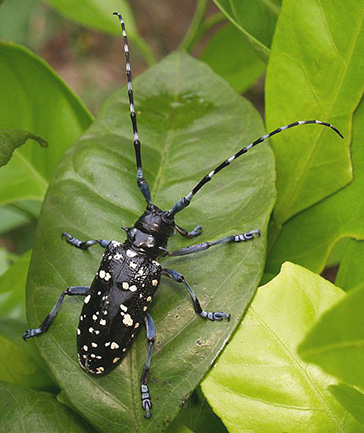Citrus Long-horned Beetle Pest Profile
Pest Profile

Photo of citrus long-horned beetle on a citrus leaf. Photo by Nigel Stott.
Description
Citrus long-horned beetles (CLHB) are shiny and black with irregular, white to pale yellow speckles on their elytra (hardened fore-wings) wings. Their long antennae have white or light blue coloration at the base of each of the 11 segments. This beetle is sexually dimorphic. Females are approximately 1.5 inches (38 mm) in length and have antennae that are slightly longer than the length of the body and elytra that leave the tip of the abdomen exposed. Males are approximately 1 inch (25 mm) in length and have antennae that are twice the length of the body and elytra that cover the abdomen entirely.
CLHB are closely related to another exotic pest, the Asian long-horned beetle (ALHB). Though they look similar, they can be identified by the bases of their elytra. The bases of CLHB elytra are bumpy while the base of ALHB wings are smooth. Both species are considered pests of concern and should be reported to the exotic pest hotline.
History and Distribution
CLHB has been intercepted occasionally on trees imported from Asia. Multiple bonsai maple trees from Korea infested with CLHB were found outdoors at a nursery in Tukwila, Washington in 2001; this infestation led to an eradication program and a quarantine, but it is not known if CLHB had actually established in the environment outside of the nursery prior to the eradication. CLHB is not known to have ever established in the environment in the United States. Though nearly all CLHB interceptions have been on live host plants, it is thought that wooden packing material could also be a pathway for introduction.
CLHB is native to Asia and is found in China, Hong Kong, Japan, South Korea, North Korea, Indonesia, Malaysia, Myanmar, Macau, Philippines, Taiwan, and Vietnam.
Multiple introductions have been reported in Europe and eradication efforts are ongoing in Croatia, France, Italy, and Turkey.
Life Cycle
Eggs: Eggs are deposited in an inverted T-shaped slit in the trunk or exposed roots. They are oblong and about 0.2 inches (5.5 mm) long and 0.07 inches (1.7 mm) wide. The eggs appear white as they are laid but become yellow or brown when they are ready to hatch.
Larvae: Larvae are approximately 0.2 inches (5 mm) long when they hatch but grow to be over 2 inches (52 mm) before pupation. They appear as pale-yellow, legless grubs with a dark-brown head. The larvae tunnel and feed between the phloem and xylem layers of the trunk and roots causing damage to the tree. As many as 90% of the larvae may be below ground level feeding on the roots.
Pupae: Pupae are 1 to 1.5 inches (27 to 38 mm) long. The life cycle usually requires one year but may take two years depending on the climate and host.
Adults: Adults emerge from the tree through a round or slightly oval exit hole 10-15 mm wide. These holes usually occur at the base of the tree or on exposed roots. For 10 to 15 days after emergence, adults feed on leaves, petioles or the bark of small branches before mating. Females mate and lay eggs throughout their life and may lay over 100 eggs in a lifetime. Adult longevity and fecundity depend on larval host quality.
Hosts
CLHB can feed on various host plants and has been recorded feeding on over 100 species from 36 families, including both hardwood and fruit trees, including citrus.
Damage and Economic Importance
Adults feed on foliage and the bark of branches, but this is not considered a source of significant damage. Most damage is done by larvae tunneling through wood. These tunnels disrupt transportation of water and nutrients and can lead to tree death. Larval tunnels also structurally weaken the trees and they may be more susceptible to wind break. Damage to the wood can also leave the trees vulnerable to secondary infections. While related species attack dead or dying trees, CLHB prefer live, healthy trees. In its native range, CLHB is considered the most serious citrus pest in its family. A study in Japan found 66% of commercial citrus trees had exit holes from this pest. Eradication efforts in Washington in response to the finds of CLHB there reached $2.2 million over five years. With such a wide host range, CLHB establishment would be an economic concern in a variety of settings. Considering California’s favorable climate and abundance of citrus hosts, CLHB would be an economically significant pest of commercial and urban citrus.
References
- CABI Invasive Species Compendium. Anoplophora Chinensis (black and white citrus longhorn)
https://www.cabi.org/isc/datasheet/5556. - EPPO Global Database. Anoplophora chinensis (ANOLCN)
https://gd.eppo.int/taxon/ANOLCN. - Haack, R. A., Hérard, F., Sun, J., & Turgeon, J. J. (2010). Managing Invasive Populations of Asian Longhorned Beetle and Citrus Longhorned Beetle: A Worldwide Perspective. Annual Review of Entomology, 55(1), 521–546.
https://doi.org/10.1146/annurev-ento-112408-085427
